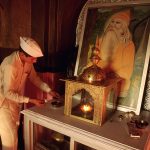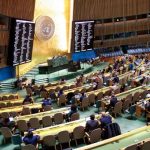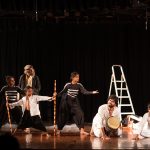Eugen Sandow: Fakir of Physical Culture
An account of the strongman’s visit to India in 1904, excerpted from David Waller’s forthcoming book The Perfect Man
 David Waller
David Waller
 David Waller
|
01 Dec, 2011
David Waller
|
01 Dec, 2011
/wp-content/uploads/2015/11/sandow.jpg)
An account of the strongman’s visit to India in 1904, excerpted from David Waller’s forthcoming book The Perfect Man
Eugen Sandow (1867-1925) is now almost totally forgotten by the broader public by whom he was once adored. The Victorian strongman rose from humble origins in Prussia to become internationally famous as the literal embodiment of masculine perfection, a century ago the possessor of the most famous male body in the world. In his heyday in the late Victorian and Edwardian era, Sandow was a music-hall celebrity and an international sex symbol. Early accounts of his performances suggest that he was capable of stirring up an erotic frenzy akin to the impact of the Beatles on their female audiences three quarters of a century later. When Sandow appeared on stage, noted an 1890 newspaper account, ‘semi delirium seized the delighted dames and damsels. Those at the back of the room leapt on the chairs: paraquet-like ejaculations, irrepressible, resounded right and left; tiny palms beat till…gloves burst at their wearer’s energy. And when Sandow, clad—a little in black and white, made the mountainous muscles of his arms wobble! Oh ladies!’ Later, in North America, society ladies paid a surcharge to attend private viewings backstage after the show, where they were encouraged to fondle his muscles.
Kings, Crowned Princes and Maharajas beat a path to the door of his fitness salon in St James’s Street. Tens of thousands who could not afford his personalised attention subscribed to his mail-order fitness courses. Scientists and artists studied him, deeming him not merely strong, but the perfect specimen of male beauty. Before him, nobody believed that a human body could copy the perfection of classical art. Artists clamoured to paint him, sculptors to model him. On an early visit to the US, Thomas Edison filmed him—one of the first moving pictures— and postcard images of his near-naked body were circulated by the thousand. He and his family lived in Dhunjibhoy House, a substantial residence in Holland Park Avenue in west London, named in honour of an Indian benefactor whom Sandow claimed to have cured of elephantiasis during a tour of the sub-continent. The following is an account of the rapturous reception he received when he made a visit to India in 1904.
Sandow’s arrival in Calcutta’s magnificent Howrah Station was a momentous occasion. The crowds gathered at least an hour before his train was due, in the words of the Indian Daily News, an assembly of:
‘…an immense number of Europeans and natives of all castes and creeds, all of whom were bent on catching the first glimpse of the great man they had for the most part heard of, but only seen in books and pictures. There were some among the native folk who gave vent to their opinions and vied with each other in describing what the great Sandow would look like. Some were quite positive he would be as large as the huge posters depict him. Suddenly the toot of the whistle announces the arrival of the long expected train, and thither that vast assembly hastened with eager footsteps, and by the time the train stopped there was an impassable barrier of human beings round the compartment occupied by Sandow. The crowd was kept back by the police, and Sandow alighted, looking fresh as ever, though a little travel-stained. He was followed the whole length of the platform by an eager crowd of ladies and gentlemen. The ignorant native element seemed to be disappointed at his appearance, for some were heard to remark that he was like any other mortal, only with a fine muscular build and set up, and certainly not the giant the huge posters depicted him to be, while others of the more educated, strained their necks over the heads of the crowd and were satisfied with a glimpse of him, and spoke in eulogistic terms of his physique. The European element were thoroughly enthusiastic, and from their demeanour it is clear that Sandow will have a warm reception.’
As proved to be the case:
‘The reception accorded Eugen Sandow at the Theatre Royal, Calcutta, was one absolutely unparalleled in the records of Calcutta…not only was the theatre full in all its departments, but in the upper circle, and also at all the door-ways and exits on both sides of the house, the crowds were standing ten and twelve deep, and hundreds had to be turned away…no entertainment that has ever come to the East has been such a big draw or aroused an audience to such a pitch of enthusiasm as that of Saturday night. It was a representative assemblage of every class of society, both European and native, and a number of the boxes were filled with native noblemen and gentlemen who had come down to Calcutta specially to see one of the modern wonders of the age…’
Sandow was exceptionally popular with all elements of Indian society, from the European ruling class to their native subjects. The British, for their part, responded less to the mystical elements of his doctrine, than the practical, military applications: given the small number of Europeans compared to the vast native population, their hold on power in the sub-continent was something of a confidence trick and anything that made the officer class physically stronger… could only help with the imperial mission. “Imperial rule can have no ultimate basis than adequate and organised physical force,” urged Lord Esher, the quintessential Edwardian courtier and future Sandow ally. This was acknowledged explicitly by an editorial in London’s Evening Standard:
‘Whether the Indian government will hasten to avail itself now of Mr Sandow’s services is not known but as we frequently hear of a lack of strong men in the administration there might be room for one of his unquestioned vigour. Personal strength has before this enabled English officials in India to maintain the prestige of empire even more than the alleged superiority of western intellect.’
Native Indians regaled him with honour and favours. He toured the country with a tent capable of holding 6,000 persons, and nightly had to turn away thousands. He was hailed as Sando Pahlwan— the honorific Pahlwan betokening physical prowess when applied to a wrestler or athlete. Gamun Baliwala Pahlwan, a champion Hindu wrestler, challenged him to a contest “so that all classes of people might see and appreciate our good points”. Sandow ducked this confrontation, knowing that a champion of the calibre of Gamun would have been difficult to beat. He befriended Maharajahs such as the Gaekwad of Baroda (who commissioned a copy of the Sandow cast for his own private museum) and the unnamed prince who took him on a forty mile drive from his palace. ‘We had not gone very far before I noticed that at regular intervals on the route various carriages and pairs were stationed,’ Sandow recalled. ‘At first I could not make out whether they were there by accident or by design, but later on I heard that for fear that the motor might, perhaps, break down, my host had ordered a carriage and pair to be waiting at every mile on the route.’
In Bombay, his new friend and benefactor Dhunjibhoy Bomanji used his influence to invite Sandow into one of his residences to give instruction to a group of high-class Parsee ladies. Normally, the zenana was out of bounds, but Sandow was given special dispensation to penetrate the inner recesses of the palace:
‘My pupils were separated from me by a beaded screen,’ he recalled, ‘and the apartment they were in darkened so that I could not see them. Some unlovely waiting women watched them very closely. On the other side of the screen where I stood all was bright, so that my mysterious pupils could easily see what I was doing. I faced the screen and commenced demonstrating the first simple exercises of my system. A quiet rustling from the other side of the screen told me that my unseen watchers were imitating my movements…’
When the lesson was finished, the ladies behind the screen passed on the message that they would be very curious to feel the muscles of his arms.
‘I approached the beaded screen and raised my biceps; and through the screen half a dozen small hands stretched out and touched them nervously.’
Exotic this experience might have been, but perhaps not as erotic as one of the private sessions in Chicago under the dubious tutelage of Florenz Ziegfeld. To avert any suggestion of improper behaviour, Sandow spelt out to his domestic readers that Mrs Sandow was at his side on his side of the screen, sharing in his amusement at this incident.
Asked meanwhile by one reporter what would happen if Bengalis took up his system en masse, Sandow answered that they would become like himself, “from delicate they will become strong.” He had plenty of examples to prove it: Ram Narayan Acharryya, who had been following the Sandow system since the age of 11, had transformed himself from a weakling into paragon of muscularity; Chaudra Perk of Calcutta ran a well-attended physical culture class; Suresh Chandra Das Gupta of Bengal managed to increase his chest size from 27 to 31 inches over a year following the Sandow correspondence course. Youths such as these were as brawny as any public school boy at home, he averred. Deploying the language of his campaigns in England, he was offering regeneration for the people of India, a message that was starkly free from racial condescension: he blamed the demonstrably poor physique of the Indian natives on poor diet and want of exercise, rather than any innate limitations of race. “’The native Indians have a foundation for the building of large physical men,’” he insisted, “it is only because of their lack of proper food and systematic exercise that they are thin and haggard.” Indians were splendid material to build on, he went on. “They will succeed absolutely. They will succeed more than any nation in the world, because they have perseverance. Look to the welfare of your body, in two hundred years you will have splendid results…”
Sandow was too conservative a figure to be stirring up the aspirations of India’s fledgling nationalists intentionally, but his message to the “teeming millions” of native Indians, as he patronisingly called them, was subversive nevertheless. He offered his followers empowerment through control of their bodies, a strange and inadvertent echo of the ideology of Turnvater Jahn, one of Sandow’s earliest influences, the founder of the German gymnastics movement who had fortified resistance to Napoleonic occupiers by bringing the youth of Germany out to exercise on the heath. Back home in England, where the authorities were still pondering the lessons of the Boer War, it was said (by Lord Meath) that gymnastics had been the first practical step on Germany’s road to recovery and now unquestioned rivalry with Great Britain. It would of course be more than four decades before the sub-continent would be liberated from British rule, but Sandow’s ideas were taken up enthusiastically. There were many who saw physical fitness as the first step on the road to independence and political power. These included Swami Vivekananda, the Hindu nationalist leader (and exponent of the three Bs: beef, biceps and the Bhagvad- Gita), and Sarala Debi Ghoshal, a niece of Rabindranath Tagore who following Sandow’s visit became an extremist leader.
‘In India, the name of Sandow represents almost a demigod to hundreds upon thousands of natives, and patients by correspondence are legion,’ noted the celebrated investigative journalist WT Stead a few years later. ‘Maharajahs have come over from India specially to take his treatment in St James’s Street. Other Indian rulers have commissioned Mr Sandow to send out his representatives to look after their physical education.’ There was a further and more surprising legacy of his visit: Sandow may have inadvertently helped initiate the modern craze for yoga. Part of the appeal of this contortionist pastime to its millions of adherents in the West today is its supposed ancient and mystical Indian antecedents, expressed in various unpronounceable Hindi names for the postures as well as the trance-like and allegedly Asiatic sense of wellbeing that it induces. In its modern or asana form, yoga is in fact a recent phenomenon, dating only from the first half of the twentieth century. According to some historians, this modern posture-based yoga owes more to western physical culture (including Sandow’s) than it does to Indian tradition. Sandow also gave his name to an early hero of Bollywood: Raja Sandow (1891-1943), so dubbed because of his impressive physique, was one of the leading actors and directors of Tamil and Hindi cinema in the 1930s and was responsible for pushing the boundaries so that revealing dresses and actual kissing were shown for the first time on Indian screens.
As Sandow’s monthly despatches to his magazine make clear, he was beguiled by India, and the appreciation was fully reciprocated: from the first he was embraced as one of the subcontinent’s own, as a kind of fakir of physical culture. Like a holy man, he had wondrous powers, not merely over the four hundred muscles in his own body (he claimed most improbably that he could stop his own heart from beating), but over other people too, holding out the promise of transformation if they only so much as followed his exercise system. He played down the rational aspect of his regime and presented it as a kind of meditation with muscles. ‘The essence of his system [is] to concentrate the mind upon the physical effort, so that mind and body may both work together to produce muscular development,’ commented an approving editorial in the Bengalee newspaper. ‘It is the cooperation of the mind with the body that makes the system so unique and explains the great results which have been attained.’
While his claims to be able to heal almost any ailment sounded preposterous in the cold light of northern Europe, in India they were not out of place at all: it was on this visit that he cured Dhunjibhoy Bomanji, a prominent Bombay shipping contractor who suffered from what was said to be elephantiasis, but was more likely goitre or a debilitating swelling. “When he first came to me he was suffering terribly…he was only about thirty-five, but had suffered from this dreadful disease for eighteen years. He had undergone an operation in London, and had consulted specialists in most European countries. After an examination, I undertook to cure him if he would follow my directions.” Christ-like, Sandow laid on his hands, and Bomanji recovered, expressing his gratitude by paying Sandow a large sum of money and trying to entice him to stay in India with a further offer of £10,000 a year. The story is not fanciful: Bomanji (1862-1937) was an immensely wealth Parsee businessmen who was later knighted for his services to the British Empire, and certainly had funds with which to express his gratitude. Sandow did not take up the offer, but when he finally settled in London he named his house after this Indian benefactor, and was a regular guest at Bomanji’s estate near Windsor. Over decades, Bomanji spent half the year in England, chiefly at The Willows on the Thames near Windsor which boasted its own railway line. He was knighted in 1922 after various services to the British Empire. Sandow claimed that Bomanji, whom he revered as the “merchant prince”, named a house after him and granted Sandow and his heirs the right to stay in Sandow Castle, Bombay: there was indeed a property of this name, set across 18 acres and overlooking the sea at a place called Pir Pau, which caused some controversy in 1947 when MA Jinnah, the founder of Pakistan, expressed an interest in buying it.
Sandow returned to Britain in September 1905, to a reception almost as triumphant as the one that greeted him in Calcutta. A brass band played See The Conquering Hero Comes as he and his wife steamed into Dover on September 18. His wife Blanche had crossed the channel to meet him after the long separation: he had been away from his children for eighteen months. A large crowd, including his two daughters and numerous female admirers, was there to meet him as he disembarked with the rest of his troupe. He was dressed impeccably in black frock coat, with buttonhole of embossed leather, dark silk waistcoat in black and red, and grey trousers. On his head he sported a black felt Trilby hat, under the broad brims of which his blonde hair curled dandyishly.
With consummate lack of political correctness, Helen, now aged nine, asked her father whether he had brought “any little nigger boys for her to play with”. Indeed, in the manner of Captain Cook, Sandow had brought back with him human souvenirs of his travels. “I have chosen and brought back with me a native of every country I have visited,” he bragged, “thirty-two in all, including Chinese, Hindus, Kaffirs, and natives of the Punjaub [sic].” Most were weaklings, whom Sandow hoped to transform through the proper application of his system, but there was a troupe of wrestlers from India, including two giant Sikhs and a middle-weight called Herichund, who were as fit and strong as any European. With their hair bound in ‘top knots’ and dressed in gaily-coloured shawls, they were soon to be launched on the music-hall stage, delighting audiences in locations as far afield as Ardwick in Manchester. But first, they and the rest of the Sandow party had to board a specially chartered train for London. On arrival at Charing Cross Station, the reception ‘attained almost Royal Proportions’, noted the Guardian. Admission to the platform was by ticket only, and a special body of policemen was in position to keep back the waiting (and, it was observed, well-behaved and physically well-developed) crowd of Sandow’s ‘admirers and followers.’
Sandow went on to create a great fortune in business. He was appointed Professor of Physical Culture to King George V in 1911. But the First World War brought about his downfall. When he died in 1925, he was largely forgotten and was buried in an unmarked grave in Putney Vale cemetery in South West London.
Excerpted from The Perfect Man, Victorian Secrets. The book is due out in December 2011

/wp-content/uploads/2025/02/Israel.jpg)











More Columns
The Case for Simplifying Green Rules Rajeev Deshpande
Grassroot Warriors Mukul Sharma
A Historic Vote at the United Nations Siddharth Singh